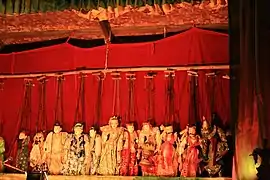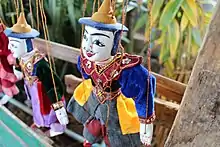Yoke thé
Yoke thé (Burmese: ရုပ်သေး; MLCTS: rupse:, IPA: [joʊʔ θé], literally "miniatures") is the Burmese name for marionette puppetry. Although the term can be used for puppetry in general, its usage usually refers to the local form of string puppetry. Like most of Burmese refined art, yoke thé performances originated from royal patronage and were gradually adapted for the wider populace. Yoke thé are almost always performed in the form of Burmese operas.
| Part of a series on the |
| Culture of Myanmar |
|---|
 |
| People |

Burmese marionettes are very intricate and their use requires dexterous skills, as they employ 18 or 19 wires for male and female characters respectively, and each puppet is controlled by only one puppeteer.
History
The probable date of the origin of Burmese marionettes is given as around 1780, during the reign of Singu Min, and their introduction is credited to the Minister of Royal Entertainment, U Thaw. From their inception, marionettes enjoyed great popularity in the courts of the Konbaung dynasty. Little has changed since the creation of the art by U Thaw, and the set of characters developed by him is still in use today. Until the conquest of Upper Burma by the British in late 1885 during the Third Anglo-Burmese War, yoke thé troupes thrived under royal patronage.
List of characters


A Burmese marionette troupe has 27 character figures.
- Nat votaress (နတ်ကတော်ရုပ်, Nat Kadaw) – two figures
- Horse (မြင်း,Myin) – one figure
- Elephant (ဆင်, Hsin) – two figures (one white, one black)
- Tiger (ကျား, Kyar) – one figure
- Monkey (Myauk) – one figure
- Parrot (Thalika) – two figures
- Alchemist (ဇော်ဂျီ, Zawgyi) – one figure
- Minister (Wungyi) – four figures
- King (Mintayar gyi) – one figure
- Prince (မင်းသား, Minthar) – one figure
- Princess (မင်းသမီး, Minthami) – one figure
- Prince Regent (Uparaja or Ain-shei-Minthar) – two figures (one white-faced, one red-faced)
- Brahmin (ပုဏ္ဏား, Ponenar) – one figure
- Hermit (Yathei) – one figure
- Nat (နတ်, Nat) – one figure
- Deva (Maha Deiwa) – one figure
- Old man (Apho-O) – one figure
- Old woman (Aphwa-O) – one figure
- Buffoon (Lu phyet) – two figures
Music
A traditional Burmese orchestra known as a hsaing waing usually provides the music. The puppeteers themselves often provide the voices of the characters.
Political role
The Burmese court was concerned with preserving the dignity of its members, and marionettes were often used to preserve the esteem of persons who had erred. The king could reprimand his children or his wife in this way by asking the puppeteers to put on a parable warning errant children or careless wives about their reckless ways. While the reprimand would be obvious to anyone who was in the know, it would largely pass unheeded by the people looking on, something that had a great deal of value in a court that could, and did, contain hundreds of people.
Burmese marionettes also served as a conduit between the ruler and his subjects. Many times, people would ask the puppeteers to mention a current event or warning to the ruler in a veiled fashion. Thus, information or popular discontent could be passed on without any disrespect, as marionettes could say things that a human could be punished for with death.[1]
Decline and revival
Yoke thé troupes, like most artisans in pre-colonial Burma alongside the Sangha, enjoyed great royal patronage. However, like most forms of traditional arts, patronage vanished upon the colonisation of Upper Burma by the British in November 1885, following the Third Anglo-Burmese War.
In the late 1990s, General Khin Nyunt of the ruling junta lent official support to marionette actors and troupes,[2] thus reviving a rapidly dying tradition.[3] Nowadays, marionettes are very common as tourist attractions and also amongst the populace, and they have resumed their role of relatively safe political satire reflecting popular discontent.[4][5][6]
Also, a new genre of yoke thé is emerging, where a character and a real life actor perform the same show, usually with the yoke thé puppets able to mimic and sometimes out-perform their human counterparts.
References
- "History of Marionettes". Puppetsnow.com. Retrieved 22 December 2013.
- Skidmore, Monique (2005). Burma at the Turn of the 21st Century. Honolulu, Hi.: University of Hawaiʻi Press. p. 242. ISBN 978-0-8248-2857-8.
- "Mandalay Marionettes Theater Puppet Show". Southeast Asia Digital Library. Board of Trustees of Northern Illinois University. Retrieved 28 June 2022.
- "The return of the puppets". The Myanmar Times. 2018-03-30. Retrieved 2019-10-22.
- "Myanmar". World Encyclopedia of Puppetry Arts. 2016-04-20. Retrieved 2019-10-22.
- "Pulling strings: a history of puppetry". The Myanmar Times. 2014-01-26. Retrieved 2019-10-22.
Further reading
- Bruns, Axel: Burmese Puppetry, Bangkok, White Lotus Press, 2006, ISBN 9789744800886
- Bruns, Axel: The Burmese Marionette Theater In: Journal of the Siam Society, vol. 82, no. 1, 1994, p. 89–96
- Foley, Kathy: Burmese Marionettes: Yokthe Thay in Transition. In: Asian Theatre Journal, Bd. 18 no. 1, spring 2001, p. 69–80
- Maung, Htin Aung (1962). Folk Elements in Burmese Buddhism. London, New York, N.Y.: Oxford University Press. OCLC 378392.
- Müller, Dominik: Cultural Politics of National Identity and Impacts of Tourism in Contemporary Myanmar – The Case of Yokthe Puppet Theatre. ERASMUS Intensive Programme Southeast Asian Studies (IP-SEAS), 2007
- Singer, Noel F.: Burmese Puppets. Oxford University Press, Singapore 1992
- Thanegi, Ma: The Illusion of Life: Burmese Marionettes. Orchid Press, Bangkok 2009
- U, Khin Zaw (1981). Burmese Culture: General and Particular. Rangoon: Sarpay Beikman Corporation Press. OCLC 15698412.